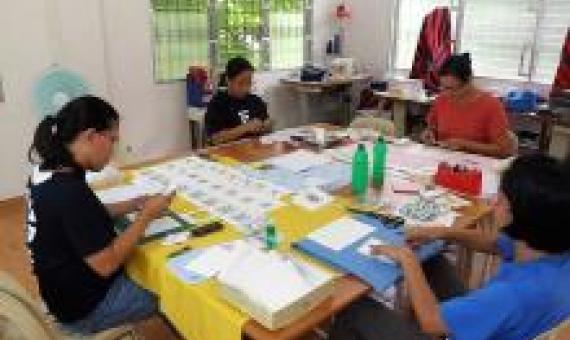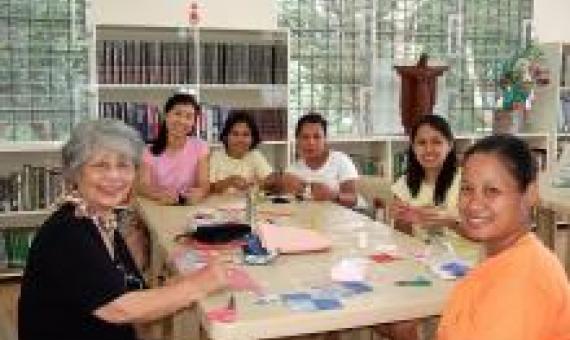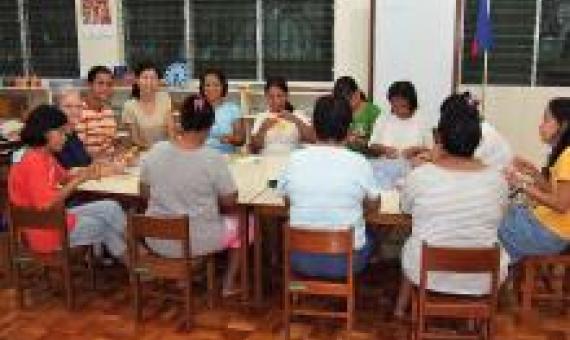Sampaguita: Creating Life's Rich Tapestry

SAMPAGUITA, the Women's Income Generating Program
of the St. Madeleine Sophie Foundation (SMSF)
in Montalban, Philippines,
celebrated its 10th anniversary.
Here are some extracts from the message given by Japan-based Saiko Kobari,
a founding member of the program who continues to fully support this venture.

SAMPAGUITA, which is named after the small, sweet-smelling national flower of the Philippines, started in 2007. I was fortunate to be part of the program at its inception. I facilitated the training of the women in sewing, embroidery, and cross-stitching. Our beginnings were difficult but we were blessed to have the precious support of persons, like Sister Pilar de Tuero rscj and Mrs. Kazuko Arita (the mother of Sister Yuka Arita rscj), and well as the help of other foreign volunteers.
SAMPAGUITA in its early years: Women at work (left photo);
learning new designs with the late Mrs. Kazuko Arita (middle photo);
and, having an activity with Sister Pilar de Tuero rscj who is now in Spain (right photo).
Being with the SAMPAGUITA project reminded me of my childhood. I learned sewing and embroidery from my mother, who regularly went to embroidery classes, flower art, lace knitting, quilt-making, among others. She enjoyed making big table cloths, with either embroidery or quilt pieces. She also sewed my summer dresses. I was always curious and happy to see her work. Long and thin embroidery threads and small pieces of materials became colorful, elegant and beautiful products.
I was brought up with love by my mother, and my childhood memories of her always include her lovely handicrafts. I had not been aware of these until I became part of the SAMPAGUITA project. Since I was always beside my mother when she was doing handicrafts, I naturally learned her secrets, which I realize now are actually my life lessons. For example, from her I learned that a series of preparations is required to put together different materials and transform it into one product; and this process requires plenty of time and patience.
When I do embroidery, I sometimes miss stitches. When that happens, I always remember my mother’s advice to go back to the point where I made a mistake and to begin again from there. That took time and challenged my patience. However, I realized that this was necessary to make things beautiful. My mother also encouraged me to be creative. Even scraps and leftover materials became useful drawstrings, or coasters with nice embroidery. By our creative efforts, things turned out to be beautiful and lively.
SAMPAGUITA is a community consisting of unique members. Each person has a gift and we share these gifts with each other. We have gone through many challenges, as individuals and as a group, over the last 10 years; but we have been able to overcome all these by helping each other and trusting God who shares our joys and sorrows. We are like the long and thin embroidery threads and small pieces of materials in different colors and forms that, when woven together, become a colorful and beautiful tapestry.

These past 10 years are your life’s rich tapestry. Through SAMPAGUITA, so many people receive the love and happiness that you put into your work. This spirit of solidarity is your contribution towards the strengthening of the SMSF family.
I would like to express my deepest gratitude to SMSF and the RSCJ, especially Sister Yuka who trusted and supported me in my work with SAMPAGUITA. Being with the SMSF family, particularly with SAMPAGUITA, has made my life so joyful and meaningful.
May all of you continue weaving our beautiful life’s rich tapestry; and may God bless you and your families. Thank you.
Saiko Kobari


